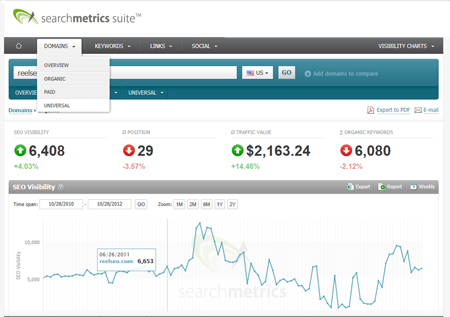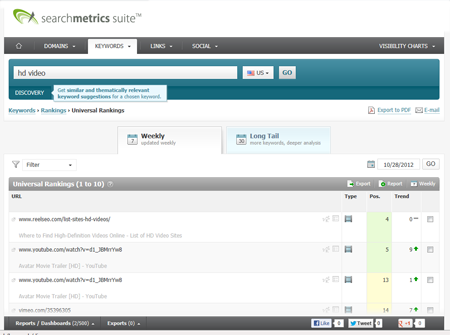
One of the easiest ways to enter a query space or SERP is to identify what Universal Search news, video, images, shopping and maps/Local verticals are in, or better still, have been in the search results. Identifying past instances that the query space included a Universal Search vertical but currently isn’t currently including the vertical is a “ranking opportunity”. Your content may drop down or disappear entirely so these queries need to be monitored closely if you wish to maintain those rankings
How Universal Search Works
User actions determine query outcomes (positive if they complete the task) and users search vertical choices are what determines the Universal Search elements that are included in the SERP, where they are positioned in the rankings and the number of or type (paks or singles without images) the search vertical receives.
The common theme you read in news and blogs is that it is Google making these choices so they can include their own properties but I’m of the opinion it is the users choices that decide the Universal Search elements that get included in the SERP. Google just uses it’s own properties to fulfill the users need because often they are best in class.
Lets make it perfectly clear here that I am not one who believes Google positions it’s products in these SERPs just to drive traffic to their properties. Mainly because Google News may not be the best news aggregator on the net, but, by no means is it woefully lacking when comparing alternative resources. SEO’s should be expected to know that the Universal Universal Elements included in any SERP are the most popular types of content chosen by users in that query space.
News, videos and shopping comprise large pieces of a user’s online activity time so it seems logical that this should also be reflected in the SERPs through the intent and interests of the user. Google has coincidently either by foresight or in its ability to develop/buy the “best of class” resources for Video, Images and shopping to fulfill these needs so I think the cries of foul are just more sour grapes and whining. Seriously? Should users be forced into another Map property when Google’s is by far the best available program? Ask any iPhone user I bet they would be thrilled to have Google Maps!
Identifying the Universal Search Content Opportunities
There are two types of ranking opportunities to get your content into Universal Search results. The best opportunity occurs where there is a history of the vertical being in the SERP and the vertical is currently missing. You should make this content immediately and while it is being prepared look at the previous instances of the vertical being in the results. Try to figure out how long it ranked; was it tied to a news or other type of event; was the product or service in season? The best way to do this is use the date range in Google’s left margin.
The second ranking opportunity for your content is to trigger entry of Universal Search elements into the results. This is a little harder since you have no data to fall back on for the type of content the Universal Search element should be. In this case you should pay a lot of attention to the query type triggers discussed later. In general user desire for online news and video
and the way these work together makes them the best two types of content to trigger entry into the SERP.
Searchmetrics the Leader in Universal Search Rank Monitoring and Vertical History
One of the first things you should do when you target a query space is to check the current SERP to see who the competition is, what Universal elements are included and the positions they are in. Next open up Searchmetrics and begin the content discovery process!

Upon entering the Suite’s Universal Module you get the visibility graph indicating how visible the site is in the Universal Search results. Like the SEO visibility graph it is a graph providing trend lines for a quick check of the health of your Universal Search listings. Searchmetrics to the best of my knowledge provides the most accurate and comprehensive data on Universal Search. You get all the Universals that have appeared in the query space since May 2010!
Going down the page I get all the universals broke down by phrase and Universal search vertical. The way the Suite is laid out you start with a higher view of the SEO visibility for Universal Search elements and as you go down the page it gets more granular ending with phrases broke down by vertical.

Clicking on a keyword in the listings brings up the results for that keyword. From here go up to the top of the page and click the Discovery button. This pane brings up modifiers on the phrase with traffic and all the types of verticals included. By far this is the best tool for finding content opportunities in Universal SERPs.

The discovery window includes not only phrase and modifiers but also another area that has the related words. In a sense you have all the phrases here you need to build the page and or content.

Our research starts with the SERP’s history because knowing what Universal elements have been included in the past is the most important information. When we know the Universal we know the triggers and types of content that the Search Engine has found relevant to the query. I don’t get hung up on knowing what specific piece of content was in the results or when it happened because these are generally event and or user intent driven.
How to Trigger Universal Search Elements
Optimization Tip: Universal Search elements are “triggered” by what Google perceives to be the intent of the user’s search. Intent is determined using the users current search session and history (if any) and aggregated user behavior. Temporal factors are influencing the SERPs more than at any other time in recent memory so fresh content is an obvious trigger for Universal Search elements to enter a SERP.
A lot goes on during a query so lets just quickly go over what may cause a Universal Search element to be included in a result. The type of query should trigger results that include the images, Videos and products; personalization (search session and history) play a role in triggering Local Search Paks. However, I assume preferred media/verticals are other personalization factors that affect rankings but these factors are impossible to know for certain.
Triggering or Entering Universal SERPs with Content Using the Query Type
The type of query plays a big role in what or if any Universal Search elements are included in the SERP. Often a query space can be what I call a hybrid result where a “Classic Google” result comprised of “10 blue links” or the result may contain Universal Search elements. Google has pretty much always had news of one sort or another in the results. However they haven’t always included a picture or video in a pak.
Generally queries can be broken down into 3 types:
- Informational: News, Videos and Images in Universal, but you will find a lot of information queries also triggering Knowledge graph results
- Navigational: News Videos Images with less Knowledge graph results
- Transactional: Images, Product Search/Paid search and depending if it is a Brand/entity query News is included
The above are not written in stone it is just a case of these seem to be the Universal Search elements that are seen most in that query type. No fancy research just general observation and perceived ability to enter a SERP of a particular query type. Once you know the query type you have a start on the type of content to produce the more granular review of the sites in the query space will help guide your content strategy going forward.
Triggering or Entering Universal SERPs with Content Using Temporal Factors
Hybrid results are often very sensitive to temporal factors especially if it is an information or transactional query. Transactional searches are heavily correlated to the Christmas shopping season and occasionally industries like apparel, sports, travel are heavily influenced by seasonality. Events often trigger Universal elements especially news and video. Hybrids are not as prevalent as in the recent past however temporal factors are still a major focus at Google as indicated in the Google Search Updates and weather reports.
Optimization Tip: Manipulating temporal factors is more about promoting content down all your channels and engaging with your users! It is not manipulation through links as in the recent past. Produce good content and be a good business person engaging with your customers. Engagement is very hard for many businesses to sustain but is a very likely means to success in the new Google environment.
News and or a Blog post with promoted Image and Video are an awesome way to leverage entry and /or raising your ranking in a query space. Adding Video and Images to a press release and/or blog post add value to the textual content and provide other or alternate traffic through content channels like Pinterest and YouTube. The next key is promoting the content through your Social media channels to create the buzz/signals to verify the content adds value and is worthy of entry into the results as a freshness element. How long you stay above the fold will be largely dependent on maintaining the rank with links and engagement.
Conclusions on Content Strategies for Universal Search
David Harry did a blog post on diagnosing a penguin problem is an example of what you can do with a proper Universal Search strategy. The query space is not competitive, however, all but 3 of the sites in the SERP are either from our social stream, embeds on a strong blog and not to mention the YouTube presence and our natural promotion of the content down our channels leveraged a single post with an embedded video into a position of owning the SERP. Links are not dead they have just changed the form they come in!
